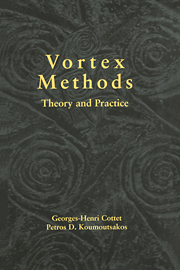Book contents
- Frontmatter
- Contents
- Preface
- 1 Definitions and Governing Equations
- 2 Vortex Methods for Two-Dimensional Flows
- 3 Three-Dimensional Vortex Methods for Inviscid Flows
- 4 Inviscid Boundary Conditions
- 5 Viscous Vortex Methods
- 6 Vorticity Boundary Conditions for the Navier–Stokes Equations
- 7 Lagrangian Grid Distortions: Problems and Solutions
- 8 Hybrid Methods
- Appendix A Mathematical Tools for the Numerical Analysis of Vortex Methods
- Appendix B Fast Multipole Methods for Three-Dimensional N-Body Problems
- Bibliography
- Index
2 - Vortex Methods for Two-Dimensional Flows
Published online by Cambridge University Press: 21 September 2009
- Frontmatter
- Contents
- Preface
- 1 Definitions and Governing Equations
- 2 Vortex Methods for Two-Dimensional Flows
- 3 Three-Dimensional Vortex Methods for Inviscid Flows
- 4 Inviscid Boundary Conditions
- 5 Viscous Vortex Methods
- 6 Vorticity Boundary Conditions for the Navier–Stokes Equations
- 7 Lagrangian Grid Distortions: Problems and Solutions
- 8 Hybrid Methods
- Appendix A Mathematical Tools for the Numerical Analysis of Vortex Methods
- Appendix B Fast Multipole Methods for Three-Dimensional N-Body Problems
- Bibliography
- Index
Summary
The simulation of phenomena governed by the two-dimensional Euler equations are the first and simplest example in which vortex methods have been successfully used. The reason can be found in Kelvin's theorem, which states that the circulation in material – or Lagrangian – elements is conserved. Mathematically, this comes from the conservative form of the vorticity equation. Following markers – or particles – where the local circulation is concentrated is thus rather natural. At the same time, the nonlinear coupling in the equations resulting from the velocity evaluation immediately poses the problem of the mollification of the particles into blobs and of the overlapping of the blobs, which soon was realized to be a central issue in vortex methods.
The two-dimensional case thus encompasses some of the most important features of vortex methods. We first introduce in Section 2.1 the properties of vortex methods by considering the classical problem of the evolution of a vortex sheet. We present in particular the results obtained by Krasny in 1986 [129, 130] that demonstrated the capabilities of vortex methods and played an important role in the modern developments of the method. We then give in Sections 2.2 to 2.4 a more conventional exposition of vortex methods and of the ingredients needed for their implementation: choice of cutoff functions, initialization procedures, and treatment of periodic boundary conditions. Section 2.6 is devoted to the convergence analysis of the method and to a review of its conservation properties.
- Type
- Chapter
- Information
- Vortex MethodsTheory and Practice, pp. 10 - 54Publisher: Cambridge University PressPrint publication year: 2000
- 5
- Cited by

